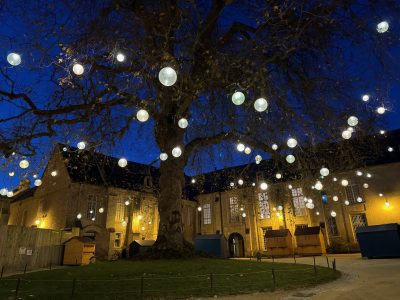By Nick Goltz, DPM, UConn Home & Garden Education Center, UConn Plant Diagnostic Lab

Using low-heat LED lights is a great way to reduce fire risk while keeping things festive. The stewards of this tree toko the extra step of installing a rope fence to discourage visitors from damaging the tree or lights. (Photo taken by Nick Goltz)
With the holidays upon us, many of us are focusing, with good reason, on last-minute gifts, travelling, reconnecting with loved ones, and all the joy and stress that will inevitably come with it. With all the hustle and bustle of the season, it can be easy to overlook some of the safety hazards that also come about this time each year, especially those involving the holiday plants that we rarely give a second thought.
On countless desks, coffee tables, and, in warmer climes, doorsteps, you are likely to encounter at least a dozen poinsettias this December. Poinsettias (Euphorbia pulcherrima) are some of the most conspicuous and popular plants associated with the holiday season here in the US. They are often thought to be highly poisonous if ingested. While ingestion may cause some mouth and skin irritation and gastrointestinal upset, sometimes with some associated vomiting or diarrhea in small animals, poinsettias are vastly “overhyped” with their supposed toxicity.
There is no documented case of human fatality associated with poinsettia ingestion, and most calls to poison control lines for ingestion report no adverse symptoms whatsoever. Medical intervention is usually unnecessary for people or pets that ingest the plant, except for those with allergic reactions to related plants (particularly those with latex sensitivity). For more information on poinsettias and their fascinating history, see Heather Zidack’s column from mid-November, “Poinsettias: The Story of a Holiday Treasure”. While poinsettias may be overblown with regard to their supposed toxicity, other common plants one might see around the holidays, including amaryllis and mistletoe, are quite toxic to humans and pets if ingested.
What we call “amaryllis” in most stores and garden centers is likely not the true South African amaryllis (Amaryllis belladonna), but rather a related South American plant in the genus Hippeastrum, which has been cultivated more extensively and has a greater number of cultivars on the market. Both are bulbous tropical plants that bloom in winter in the northern hemisphere, and both are poisonous if ingested. The bulb, commonly sold waxed or bare in stores around the holidays to be used as a table centerpiece or hostess gift, is especially toxic and should be kept away from pets and children. If you’re curious to learn more about the history and cultivation of this holiday plant, check out Dr. Matt Lisy’s recent blog post, “Amazing Amaryllis” on the UConn Home & Garden Center’s very own Ladybug Blog (https://uconnladybug.wordpress.com/).
Though in antiquity it represented fertility and offered protection from evil, mistletoe (usually Viscum album, European mistletoe and Phoradendron leucarpum, American mistletoe) has been associated with Christmas since some point in the late 1700’s. Though lovers may steal a kiss or two beneath the mistletoe this Christmas, be sure the mistletoe can’t be stolen by children or pets as you decorate for your holiday party! Although European mistletoe is more toxic than American mistletoe, both plants are dangerous if ingested, particularly by pets and children, who may be attracted to the small white berries that have a high concentration of toxin. If you know someone that accidentally ingests a plant not known to be edible, be sure to contact the poison control hotline by calling 1-800-222-1222 or by visiting https://www.poison.org. For pets, contact the ASPCA poison control hotline by calling 1-888-426-4435 or by visiting https://www.aspca.org/pet-care/animal-poison-control. Conveniently, they have a poisonous plants list on this site that you can reference as you shop at your local nursery or garden center.
Though thankfully Christmas trees (typically fir, pine, or spruce) are not known to be toxic to pets if ingested, the sharp needles can cause injury if ingested and the trees themselves can pose other hazards if not maintained with care! If you have a pet that likes to chew through wires (there is a scene in a famous Christmas movie that likely comes to mind), be sure to keep those out of reach, or perhaps opt for battery-powered illuminating ornaments. For their safety and yours, cats and birds should always be discouraged from climbing or flying into your tree!
Finally, though we all can appreciate rustic and vintage holiday décor, another strategy to reduce the risk of fire this holiday season is to upgrade your string lights to low-heat LEDs. Whatever type of string light you use, unplug it before you go to bed to help reduce fire risk. If you use a live tree, be sure to keep it watered as dehydrated trees are more likely to catch fire.
With these tips in mind, the Plant and Soil Health team at UConn wishes you and your loved ones a safe, joyous, and restorative holiday season! For questions regarding winter plant safety or for any other gardening questions throughout the year, contact the UConn Home & Garden Education Center for free advice by calling (877) 486-6271, toll-free, visit our web site at www.homegarden.cahnr.uconn.edu/, or contact your local Cooperative Extension Center.